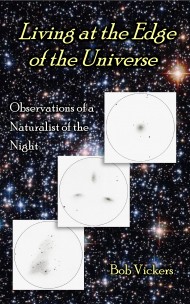This blog entry has gotten delayed due to a very busy holiday schedule at work, but better late than never….
The skies were exceptionally clear Thursday before last (12/13/12) and the night was not as cold as it had been for the previous few nights. I went out early to observe and, as part of the Astronomical League Galaxy Groups & Clusters list, re-visited the Pegasus I cluster that I had explored three years ago with my 12.5” dob. This is an interesting cluster on the border between the constellations Pegasus and Pisces, whose components are around 200 million light years away. It is a fairly rich cluster with two bright, large elliptical galaxies (N7619 & N7626) slightly off center, surrounded by several smaller and dimmer galaxies. The two bright ones were easy direct vision objects with stellar nuclei, bright cores and halo’s about 2.5 minutes in diameter. A couple of other dimmer galaxies were visible by direct vision of the nucleus only. Six of the ten galaxies that I saw required averted vision. I picked up three new galaxies this time with the 18” Obsession. They were IC 5309 at mag 13.7, N7615 at mag 14.3, and N7621 at mag 15.7. All three were visible more than 50% of the time with averted vision. See the sketch below:
 Astronomical League Additional Group #50 (aka NGC 7619 Group or Pegasus I Group) – Copyright (c) 2012 Robert D. Vickers, Jr.
Astronomical League Additional Group #50 (aka NGC 7619 Group or Pegasus I Group) – Copyright (c) 2012 Robert D. Vickers, Jr.This was also one of the peak nights for the Geminid meteor shower, so after finishing my sketch of the Pegasus I cluster, I lay down on the floor of the observatory and looked up for an hour or so. After the first twenty minutes, I had seen nothing and was seriously considering packing it in when two bright Geminids shot across the sky within about 30 seconds of each other. Over the next 40 minutes, I saw another fourteen meteors for a total of sixteen for the night. (I might have seen more if my view had not been restricted by the walls of the roll-off-roof observatory, but I was more comfortable there than I would have been in the yard.) Fourteen were Geminids streaking away from the radiant in the constellation Gemini, and nine of them were bright. A couple lasted between one and three seconds and left a smoky train behind. It turned out to be a very nice show and I’m glad I stayed out a little longer to see it. I wish I could have watched even more but, alas, I had to get up and go to work the next day.

